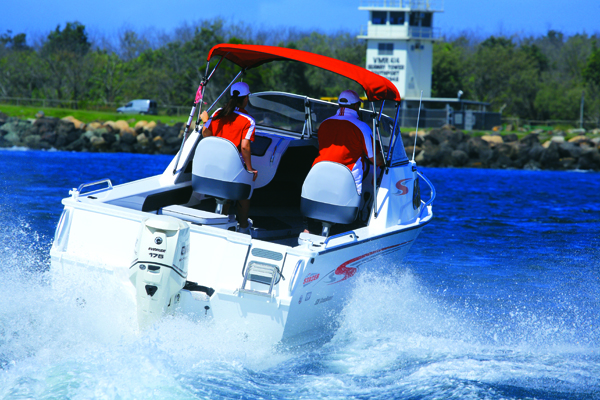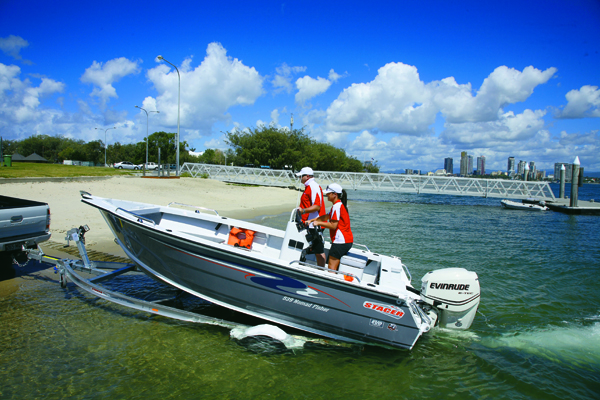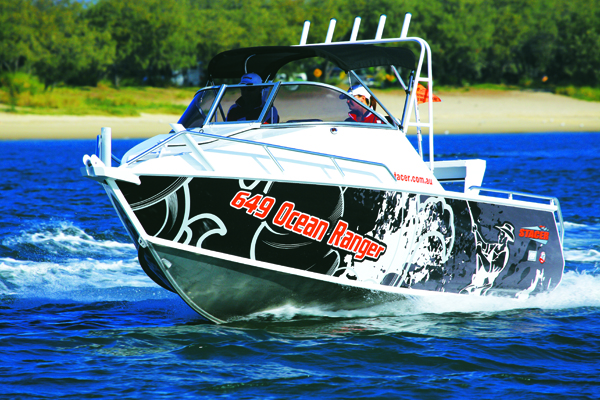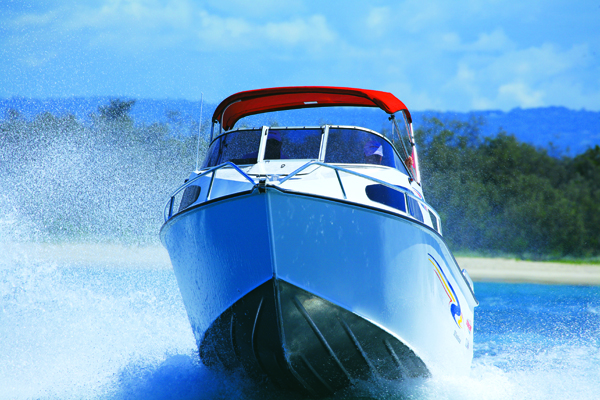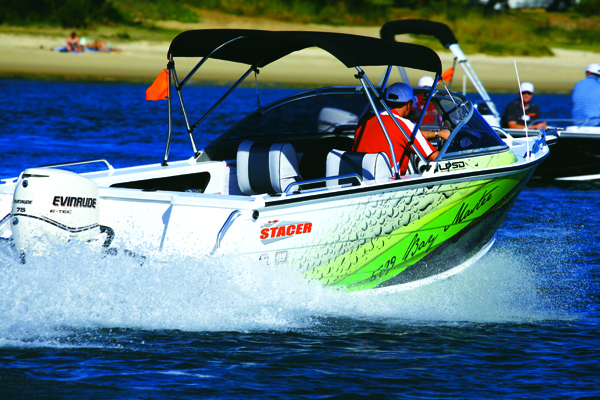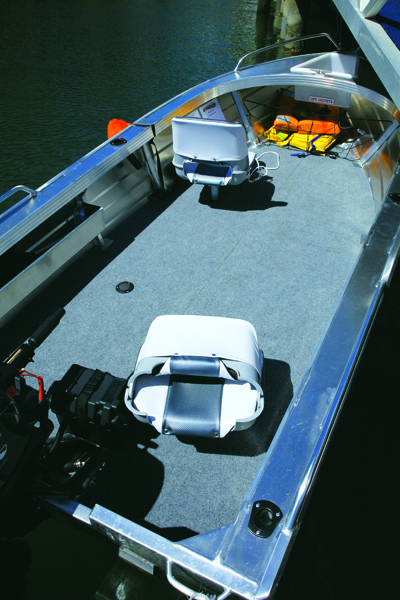Stacer - Evo Advance
- NAFA
- Jul 1, 2012
- 6 min read
The release of what Stacer called its Evo Advance hull two years ago ushered in a whole new era for one of the longest-established, aluminium-boat brand names in Australian fishing. Evo Advance delivered exceptional boat-riding comfort, and the 2012 range has been expanded at both ends, with some smart fine tuning throughout the range. With some clever new geometry and what, for a traditionally fairly-conservative boat builder, amounted to a radical rethink of the rake angle at the bows, Evo Advance put Stacer firmly in second place behind Quintrex as the best-riding tinnies around. It also put them a significant step ahead of all the rest of the horde of aluminium boat brands built in a country with an unashamed and ongoing mania for tinnies. Whether the tinnies are intended for going fishing or containing beer makes no difference to us eh? Funnily enough though, having the second-best hull behind Quintrex’s stretch-formed, world-leading Millennium hull has never made Stacer second best in other ways. In fact, for many fishos - this writer included- I must confess Stacer’s typically-simpler and ever-practical interiors often put it on at least equal footing; and sometimes even in front with classics like the SF series (loosely following a theme established by Quintrex’s original Hornets) and the Top Ender-style Nomads. 2010 also brought the Northern Fisher series, basic unpainted fishing boats designed for hard work and featuring flat, carpeted decks with a raised casting platform in the bows, welded side decks, centre consoles standard and a very short options list. Super practical and very effective fishing boats, the 4.5m and 5.2m Northern Fishers proved immediately popular amongst our mob – and continue to be so. This year they’re joined by the only thing missing from the Northern Fisher range: a smaller 4.3m model. The 429 Northern Fisher goes right back to basics with a flat deck bow to stern, while casting decks and a console are now options. Designed for 25-30hp 2-stroke outboards with a maximum rating of 40, the 429 is a smart move, making a great little fishing boat available at minimum price with a few frills available if the budget can be stretched a little further. Stacer annual upgrades for 2012 add several more models to my “classic” category. Evo Advance not being broke in any way at all, it sensibly left well enough alone with the hull shape and focussed instead on fine tuning. One of the more notable fine tunes though isn’t to the Stacer boats at all but to its inhouse trailers. Being well known for my opinions about wrecking good boats with crappy trailers, I can happily report the changes to Stacer’s trailers look pretty good. A new chassis design is claimed to increase torsional strength by 50%, which I can only quote while putting on my old metal-worker hat and observing that the new design should be markedly stronger. I’ve welded enough broken trailers in my time to be confident my comment has some merit, and should mention in passing that I never rated Stacer’s earlier trailers amongst the crappy ones. Another addition to these latest Stacer trailers is a drive on/off Vee Loader system which was demonstrated during the 2012 Stacer media day by one of its marketing ladies (an extremely nervous marketing lady with only a couple of years around boats on her CV so far) driving a 539 Nomad on and off the trailer several times in front of the assembled boating press. Seems the Vee Loader system works remarkably well. (And Eb really shouldn’t be so nervous about her boat handling skills.) Hull wise, the only structural changes are at the transom. One reason I’ve liked Stacer interiors has, for several years, been that they wasted less casting-deck space than competitors. There’s always room for improvement though and the 2012 rethink has made Stacer transoms even better in several ways. I couldn’t measure it but Stacer claims to have gained up to 200mm of interior space while fine-tuning transom and splash-well configurations. Extra space is good of course, although is more relevant to some models than others. I was more impressed with a new system to mount dual battery systems and oil tanks lower in the hull. Lowering the centre of gravity by placing heavy items like this further down is always a good thing. This rearrangement also allows better access to the bilge pump. Making it easier to clear the bilge pump impeller when your clod of a fishing mate’s braid offcuts jam it; and will also help air out the bilge after a trip. Meanwhile, routing for cabling and wiring has been tidied up and last, but certainly not least, the new transom design levels the bottom of the splash-well each side of the motor mount. Instead of water accumulating in the well and taking forever to drain overboard through piddling little drains, it can get out swoosh through a wide gap. A small refinement perhaps, but 20kg and more of water waiting to get out of an engine well never did do any good for a hull’s centre of gravity or its fore and aft balance. The media day presented us with the usual selection of models of little interest to fishermen to zoom around in with a couple that stood out as attention grabbers. Actually, some of the runabouts, family cabin boats, and bowriders did stand out thanks to some dramatic vinyl-wrap graphics. Vinyl wraps are a bit of a flavour of the month on boats generally at present. Check out any tournament coverage and you’ll see what I mean. Meanwhile, the average fisho still tends to go for unpainted aluminium because, while it looks ordinary when the boat is new, it’s ordinariness doesn’t get any worse after a few years of hard use. Nonetheless, if dramatic graphics are your thing, even I must admit they can give any boat one hell of a wow factor. One of two new Stacer models I singled out as of especial interest to NAFA readers featured particularly wild black-and-white graphics. Hmmm, even half cabs can look the goods apparently. Looking past the graphics, not an easy thing to do, the 649 Ocean Ranger was quite a boat by any measure. Sheer physical size drew attention in itself and, with 6.5m of 5mm plate hull to play with, the monster Ocean Ranger combined a spacious cockpit (with self-draining deck) with a roomy cabin in the best tradition of half cabs that function equally as well as serious offshore fishing boats and family cruisers. Australian-built boats have made this genre an art form over many generations already although, in a reversal of our national obsession with aluminium boats, it’s been ‘glass boats from the likes of Seafarer, Cruise Craft, Haines Hunter, Signature and, notably in more-recent times, Evolution that lead the way. Plate aluminium boats have long been a popular alternative, although an alternative often selling because of their ease of being customised more than on performance or value for money. Production plate boats, and especially production plate boats built well enough to suit discerning buyers and in enough volume to make them real value for money packages, have been few and far between and that’s where the 649 Ocean Runner sits. Take a look at it; it’s very well put together indeed. The other new model was my favourite on the day. The model name 539 Nomad Fisher is hardly attention grabbing but the boat itself certainly is. Well, actually the boat presented on the media day was perhaps the most ordinary looking one there with its battleship grey paintwork and a simple swirly graphic amidst a bright green, fluoro orange (and black and white) frenzy of runabouts, bowriders and half cabs. Even though it didn’t stand out with wild graphics, the fishing mag journos to a man all took time out to give the 539 Nomad Fisher a good going over. In concept, I suppose a console sited well aft is more aligned with northern thinking than elsewhere in the country, although it would make travel more comfortable over rough water anywhere and I doubt the layout won’t be popular right around the coast. The media boat had a small upholstered fish box set against the transom as helm seating but when I questioned the choice in an otherwise brilliant layout I was quickly informed that pedestal seat spigots will be going into production boats…which makes the 539 Nomad Fisher pretty much a 5.4m Top Ender style with the northern favoured aft-set console. It’s built over a 4mm bottom and 3mm topsides “plate” hull with a (self-draining) checkerplate deck and a carpeted raised casting deck in the bows with the usual stowage lockers underneath. In front of the console, a massive hatch accesses an in-deck fish pit which of course can be drained overboard. One of the latest transom designs maintains a massive interior space. The media boat ran a punchy 115 E-TEC on the transom so acceleration and performance were entertaining – he says with a big grin. Brisbane Stacer dealer Wynnum Marine was quoting around 40 grand for the package with a Stacer trailer and the E-TEC 115. The neat rake at the bows of Stacer’s Evo Advance hull and low rails made it a good looker to go along with the fun factor at speed and a VERY fishable interior. Stuff the grey paintwork and lack of woo hoo graphics; if I was going to steal a boat and take it home from the media day, it would have been this one!






